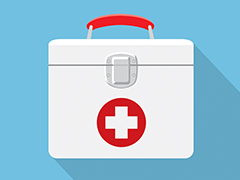Emergency or Urgency?

As summer winds down you may be squeezing in some final vacations, barbecues, outdoor adventures and more. Despite your best efforts at preparedness, sometimes accidents or unexpected events happen. We’ll help you navigate some of the care options for different medical issues.
You might be most familiar with the traditional emergency room at a hospital, but there are other options for immediate needs. Urgent care centers are a cross between a clinic and emergency room.
When you might consider an urgent care center.
Urgent care centers can handle quite a few situations that are not immediately life-threatening like:
- Earache and sinus pain
- Suspected broken bones (not accompanied by severe trauma)
- Sports injuries
- Eye problems
- Cuts that require stitches
- Cough, sore throat, fever and flu
- Minor burns
- Animal bites
- Rashes and skin irritations
- Urinary tract infections
- Vomiting, diarrhea and belly pain
- Headache
Urgent care centers have a lot of medical capabilities and can perform many different services like X-rays, minor procedures and providing stitches.
When you should go to the emergency room (ER).
A hospital ER (or calling 911) is where you should go for life-threatening issues and situations like:
- Signs of a heart attack
- Signs of a stroke
- Severe trauma like a head injury
- Loss of consciousness
- Severe bleeding that doesn’t stop with pressure after five minutes
- Poisoning
- Difficulty breathing
While it’s true that an ER can handle the same things as an urgent care center, it also takes more time to see patients and provide treatment. Emergency rooms prioritize the sickest patients first. The average wait time to see a provider in a U.S. emergency room is about 30 minutes. The less urgent your situation, the longer you’ll probably wait. The average treatment time is 90 minutes.
Most urgent care centers have patients in and out the door in an hour or less. This includes both wait time and treatment time.
Have a question for a doctor but don’t want to wait for an appointment? Telehealth options are available for non-emergency services provided by phone or secure online video/messaging through the Teladoc network. You can get care for minor or acute conditions like allergies or cold and flu symptoms. Virtual dermatology care, behavioral health care and nutritional counseling are also available.
Getting familiar with your options now before you and your family need care is important. It can help you save time and money. For more details on where to go for care, you can learn more here.


